Read Reviews
The Best Greenhouse Heaters
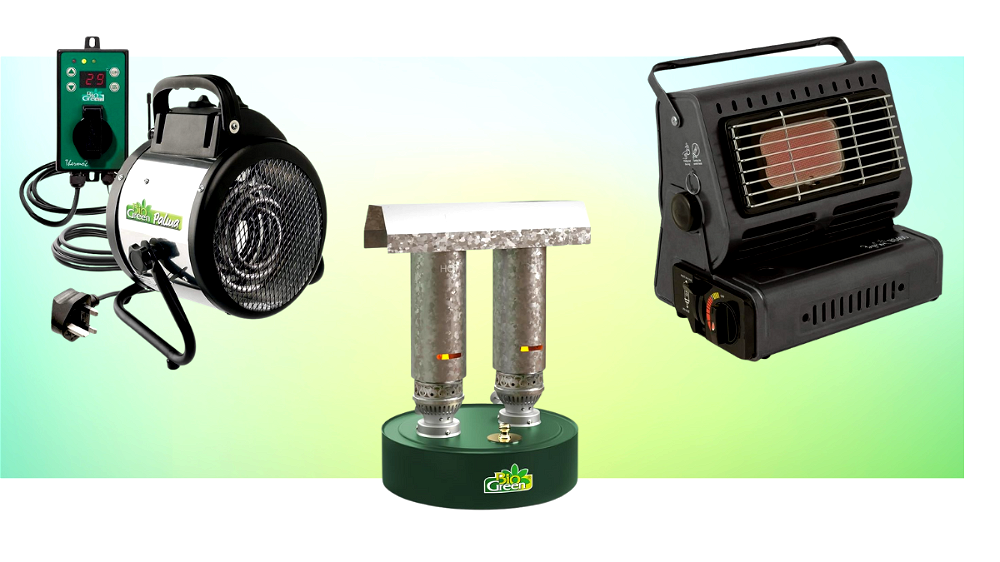
-
Bio Green Palma Greenhouse Heater with Digital Thermostat 2KW
-
2kW Electric Greenhouse Heater
-
Bright Spark BS400 Portable Gas Heater
-
Dimplex ECOT 1ft Tubular Heater with Thermostat
-
Biogreen WM-P5 Warmax Power5 Paraffin Heater
Greenhouse Heater Reviews
- Included external thermostat can be placed remotely where your plants are for greater temperature accuracy
- Well built and sturdy metal construction, capable of withstanding tough greenhouse conditions
- Sufficiently powerful to help with overwintering plants and caring for some tropical plants in winter too
- Good power output for a standard-size greenhouse - 2.4 x 1.8 m (8 x 6 ft)
- Useful cable length of approx. 2.5 m
- Not as effective at raising temperature in larger spaces - can still keep frost at bay
To keep energy bills down, whilst still keeping temperatures up, this Bio Green Palma Greenhouse Heater is a great option to consider.
Not only is this greenhouse heater sufficiently powerful, with a 2 KW output, to keep temperatures comfortable in standard greenhouses, but it also comes with a digital thermostat that will help control the amount of energy used.
Unlike many other heaters, the Bio Green Heater has an external thermostat that can be positioned right next to your plants. It therefore bases its temperature readings on what the plants feel, not just the temperature immediately next to the heater.
The digital thermostat can be set to a specific temperatures and offers accurate temperature control: it efficiently maintains the desired heat output. When the thermostat switches off, it switches back on in good time to stop the temperature from dropping too low.
There are no others adjustments for temperature control, so you have to run the this heater on the 2 kW setting. Therefore, the thermostat is the only way to control energy usage.
In terms of construction, it’s a robust unit overall, with a stainless-steel body and plastic handle. Plus, it has a water-resistance rating of IPX4, meaning that it this Bio Green heater will be protected from splashing washer (great news for anyone with a tendency to slop the ol’ watering can around!).
To give an idea of this greenhouse heater’s effectiveness, customers have reported success when using it for a variety of different functions: from overwintering plants and seedlings, to looking after tropical plants such as bananas.
With its power output of 2 kW, it’s the best greenhouse heater for achieving good temperatures over winter. In a standard 2.4 x 1.8 m (8 x 6 ft) greenhouse, the heater can dramatically increase the temperature by several degrees. In larger greenhouses (approx. 5.5 x 2.5 m / 18 x 8 ft) it can still be efficient at warding off frost.
Did you find this review helpful?
- Robust and sturdy metal construction - capable of withstanding tough greenhouse conditions
- Easy to install and straightforward to use
- Versatile - can be used as either a heater or a cooling fan
- Carry handle makes it easy to move around if needed
- The fan runs continuously in the heating modes which means this heater costs more to run than others on the market
- Not big or powerful enough to heat larger greenhouses - best for small spaces
Effective electric heaters can be expensive, but fortunately this 2kW Electric Greenhouse Heater offers good value for money; it will make a significant increase to temperature in your greenhouse, without making a dramatic decrease to your bank balance.
This greenhouse heater has a simple design, with three different heat settings: cool fan only, and 1 kW or 2 kW heat. This gives a decent amount of temperature control. There is also a thermostat that helps with controlling energy usage.
Even on the lower 1 kW power output, this heater is capable of providing a reasonable amount of heat to a standard 2.4 x 1.8 m (8 x 6 ft) greenhouse. For example, when it drops below freezing outside, it can keep temperatures at least above 5°C in the greenhouse (and often significantly higher, depending on existing insulation).
When the thermostat switches off, it only shuts down the heating element, leaving the fan running. As a result, this greenhouse heater’s energy usage will may slightly higher than if the thermostat prompted the whole unit to switch off entirely.
An additional positive note regarding the thermostat: it’s relatively accurate and doesn’t let temperatures drop too much before turning back on.
In terms of construction, this heater is sturdily made with a solid metal case. On the downside, there is no mention of waterproofing, so it may not be suitable for a very high-humidity environment.
All things considered, if you’re after value for money, this is one of the best greenhouse heaters to go for.
Although it may not have all of the features of the Bio Green Palma Heater – such as an external thermostat – it’s still a robust and effective model. Plus, it’s less expensive.
Did you find this review helpful?
- Can be used in greenhouses where there is no mains power available
- Takes the chill off small spaces in the winter months
- Gas canisters are easy to remove and replace
- Produces an impressive amount of heat for such a small unit
- Lightweight and compact - easy to carry around whilst working in different outbuildings during winter
- No thermostatic control so needs to be switched on and off manually
- Relatively high gas consumption - one canister every three hours - can mean that heating costs add up
- Better for supplying short bursts of heat rather than maintaining a steady, elevated temperature
No mains power in the greenhouse? No problem! The Bright Spark BS400 Portable Gas Heater is a useful little heater that doesn’t rely on having a socket nearby.
As gas heaters go, it’s pretty small and compact, with a foldable handle that makes it easy to take with you as you move between the greenhouse, shed and garage during winter.
It’s worth mentioning straight away that, because there’s no thermostat, this greenhouse heater it better for supplying shorter bursts of heat, as opposed to being expected to run all night long. It’s fuelled by a butane gas cartridge (not included), and one canister lasts approximately three hours.
When running, the 1.3 kW heat output can kick out some real warmth, even on the low setting. There is a dial to adjust the thermostat in order to give better temperature control. Overall, it would be a good greenhouse heater for keeping you toasty as you work in the greenhouse during the winter months.
Due to its compact design, this heater is extremely versatile. It’s one of the best heaters if you want something portable that can be used in a lot of different contexts. Seeing as it doesn’t rely on a mains power supply, it can also be used when camping or sitting out on the patio.
If you don’t have a way to run an electric heater in your greenhouse, this is the best gas heater to consider. It can take off the chill, but won’t raise temperatures to a large degree.
Running time is finite, but the gas canisters are easy to remove and replace. The only thing to bear in mind is that you’ll need to keep buying more which is an expense that can add up over time.
Did you find this review helpful?
- Extremely cost effective to run - potentially costing just a few pounds per month
- Does a great job at protecting plants from frost and taking the chill off freezing days
- Thermostatic control means it saves power by turning off toe maintain the desired temperature
- Comes with mounting brackets that make it very easy to install
- Needs to be wall mounted which can be difficult in some greenhouses
- No specific temperature markings on the thermostat dial, only 'min' and 'max'
- Won't significantly raise temperature by several degrees - simply takes the edge off freezing greenhouses
- 1.5 m cable may not be long enough to reach power socket depending on greenhouse layout
Sometimes, keeping the greenhouse free of frost is all you need – and there’s no need to spend loads to achieve it. This Dimplex ECOT 1 ft Tubular Heater is cost effective, both to buy and to run, and will stop plants from withering under the icy claws of Jack Frost.
Running at just 40 W, it might not seem like much, but this greenhouse heater creates enough heat to keep temperatures above freezing in small greenhouses. Plus, such low wattage means that it’s relatively cheap to run and can be left on for extended periods.
The tube heater also has a built-in thermostat to further control energy consumption. There are no temperatures marked, but instead a scale ranging from ‘min’ to ‘max’. There is no specific frost setting, so some trial and error may be required to find the right temperature.
As a tubular heater, it’s easily mounted onto wall brackets; the benefit of this is that it can be kept out the way, allowing you to benefit from more floor space in your greenhouse. The mounting brackets are included.
It’s IPX4 rated, making it splash-proof and safe for use in greenhouse conditions. As a result, there should be no complaints from this greenhouse heater if you are slightly over zealous with your watering can.
Whilst this is overall a very useful heater, and one of the best greenhouse heaters for keeping frost at bay, it does have one primary shortcoming. The power cable is only 1.5 m long, which can be a little short for some greenhouses, particularly if the socket is awkwardly positioned – just something to be aware of.
Did you find this review helpful?
- Does a good job keeping small to medium greenhouses frost free
- Versatile warmth levels with 4 wicks that can be lit individually or together
- Open flame is covered by flues to make running the heater safer than an uncovered flame
- Heater can burn for several days on one tank of fuel
- Only effective in small greenhouses, can’t be used to heat large spaces
- Brass plug to the paraffin reservoir can be difficult to unscrew
- The metal flues can bend so care needs to be taken when removing and replacing them
- Paraffin can be costly to buy - although at least this heater is economical with its usage
Paraffin greenhouse heaters like the Bio Green Warmax Power 5 Heater have been popular amongst gardeners for a long time. It’s easy to see why, given that this model is efficient, easy to use and practical.
First of all, there’s no requirement to have a mains power socket nearby, making this Bio Green heater viable for all kinds of greenhouses. Secondly, the heat output can be adjusted depending on how many wicks are lit, and it can burn for several days.
This greenhouse heater has a paraffin tank with a capacity of 4.5 L. It requires a funnel (not included) to help with the fuelling process. As mentioned, this is enough paraffin to keep the heater going for approximately three days.
With both burners lit, this Bio Green greenhouse heater has the power to keep temperatures above freezing in a 3 x 2.4 m (10 x 8 ft) greenhouse. It’s also suitable for smaller greenhouses as it’s possible to only light one of the four 30 cm wicks. This means that you can achieve some temperature control as well. Plus, less fuel can be used the majority of the time, but if a boost is needed, the other wicks can be lit.
In terms of safety, the open flame is covered by the flues, so there’s no naked flame to worry about. However, it’s worth noting that the strength of the metal flues could be higher, and some care needs to be taken not to bend them when removing and replacing them.
Although paraffin can be expensive to buy, this paraffin greenhouse heater is at least economical in its usage. It’s therefore the best greenhouse heater to buy if you want something that’s gas powered but not too costly to run for longer periods of time.
Did you find this review helpful?
How to Choose the Best Greenhouse Heater
Different Types of Greenhouse Heater
There are a few different types of greenhouse heater available, and different styles can be more (or less) useful, depending on the situation. Here’s a run down of the most common greenhouse heaters.
READ NEXT: The Best Greenhouse Thermometers
Paraffin Heaters
Heaters that use paraffin in greenhouses have been around for years. Even now, they haven’t veered much from their original designs. They have a tank that is filled with paraffin, and a wick that soaks in the paraffin and slowly burns down. A paraffin heater can have more than one wick, and the ‘power’ output of the heater is usually determined by how many wicks are lit.
The benefits of using a paraffin heater are that they can be used anywhere (with no need for a power socket) and they can run for a long time without needing refuelling. Heaters with a tank of 4 L+ will be able to burn for several days.
Whilst this can make paraffin heaters seem an economical option, buying paraffin gas in the first place can add up. A greenhouse heater that uses paraffin may be more expensive to run than an economical electric heater; nevertheless, if you don’t have anywhere to plug in an electric greenhouse heater, paraffin heating may be the most viable option. Their wicks will also need replacing once they burn down.
You will need to consider creating an ‘exhaust hole’ in your greenhouse if you choose to use an unvented gas heater.
Gas Canister Heaters (eg. Butane/propane)
Much like paraffin greenhouse heaters, heaters which are fuelled by gas canisters (commonly filled with butane or propane) can be used wherever necessary. They don’t rely on the presence of a nearby plug socket.
Due to the small size of greenhouse heaters in general, butane/propane heaters will likely only be able to carry a small gas canister. As a result, they do not tend to burn for as long as paraffin heaters.
Butane and propane greenhouse heaters are useful for supplying heat for a few hours, but it is unlikely that a small gas canister will last the whole night.
Electric Fan Heaters
The cost of running electric heaters can add up; however, they can also be some of the most effective heaters for dramatically increasing the temperatures inside a greenhouse (depending on their wattage).
To run an electric fan heater, you’ll need a waterproof power socket sufficiently close to where you wish to place the greenhouse heater. This can pose a problem in some greenhouses.
Fan heaters may come with a choice of heat settings, and/or a built-in thermostat. Both of these can be useful when it comes to trying to curb energy consumption.
An effective 2 kW electric fan heater has the power to keep the greenhouse temperature above 5°C even when it’s freezing outside. However, as you can see below (in the section titled ‘Energy Efficiency and Running Costs’), constantly running a greenhouse heater on this power could get expensive, fast.
Another benefit of fan heaters is that they help with air circulation. This can stop air from stagnating which can lead to mildew and cause problems with rot and mould. Air circulation is very useful in greenhouses.
READ NEXT: The Best Fan Heaters
Low-Power Electric Tubular Heaters
A low power, electric heater can be very effective at preventing frost inside a greenhouse; however, they’re not suitable for significantly raising the temperature more than that. Electric tube heaters can require as little as 40 W to run (or less). Therefore, they can be left on consistently without there being too much danger of racking up huge electricity bills.
They’re a good option for keeping temperatures just above 0°C, but you can’t expect much more from them – especially if it’s very cold out. They have quite a low heat output overall, but it’s sufficient to stop greenhouse plants getting affected by frost.
Energy Efficiency and Running Costs
Most greenhouse heaters are designed to be as energy-efficient as possible. By nature, electric greenhouse heaters are known to be extremely energy efficient; however, this doesn’t necessarily mean they’re the cheapest to run.
Gas heating in a greenhouse it generally considered to be a relatively cheap option. Using a gas heater can keep costs down because you know exactly how much money you have spent on fuel before it even starts heating. Gas greenhouse heaters are like one of those pay-as-you-go electricity meters – you’ll be aware of all costs for running the heater up front.
Even so, electric heaters are very energy efficient. They also don’t produce fumes, as gas heaters do, and therefore don’t require any ventilation in the greenhouse which leads to heat escaping. However, it can be very costly to leave an electric heater on for days on end (depending on the type of heater you choose).
The cost of running an electric greenhouse heater depends on the kW setting of the heater.
If you pay your electricity company 28p per kWh (which is roughly the UK average, but you should check your specific rate) then it will cost 28p (£0.28) to run a 1 kW greenhouse heater for an hour. Therefore, it will cost approximately 84p to run a 3 kW heater for an hour. And if you run a 3 kW heater for 8 hours… well, you’re looking at a running cost of £6.72 for that time period.
If you only know the wattage of a machine, and not the number of kilowatts, you need to divide the number of watts by 1000 to find out how many kilowatts it uses. A 2000 W machine will use 2 kW.
With all this information in mind, you should look carefully at the power of the heater you’re thinking to buy.
Look for a heater with adjustable settings, and work out how long you can realistically afford to keep it running for (and if that will actually serve your desired purpose or not).
Don’t Forget to Insulate
Whilst buying a greenhouse heater can help improve temperatures, if the greenhouse isn’t well insulated a lot of that heat will escape.
READ NEXT: How to Heat a Greenhouse in Winter Without Electricity
Sealing any cracks or holes will be crucial for keeping the greenhouse temperature up over winter. But that’s not all you can do – a lot of gardeners put up insulation in order to keep warm air inside the greenhouse (and insulation can also help seal any leftover draughts).
Bear in mind, with unvented gas heaters you will need to leave some sort of ventilation. Therefore, some heat will escape.
One of the most popular types of insulation for greenhouses is bubble wrap. Whilst standard bubble wrap can be used, and be somewhat effective, it’s better to buy a product that has been specifically designed for greenhouse insulation. Look out for large bubbles and UV-resistant materials. This will help enough light enter the greenhouse and ensure that the bubble wrap doesn’t degrade.
You can also use horticultural fleece to insulate the greenhouse. Fleece can help reduce condensation as it is more breathable. However, it blocks more light than bubble wrap.
READ NEXT: How to Prepare Your Greenhouse For Winter
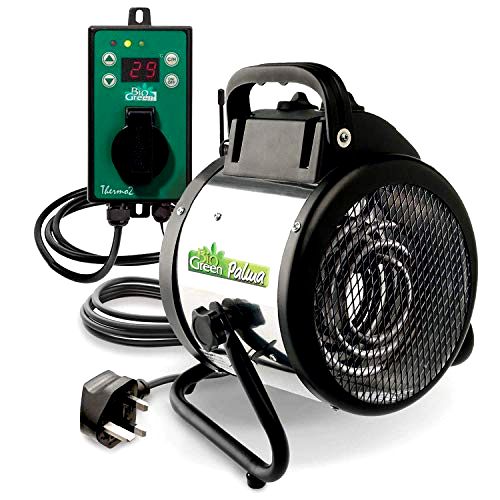

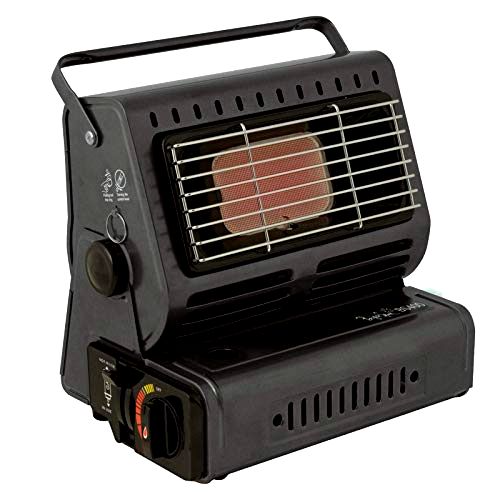
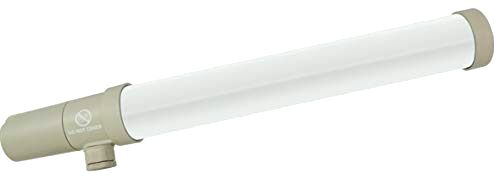
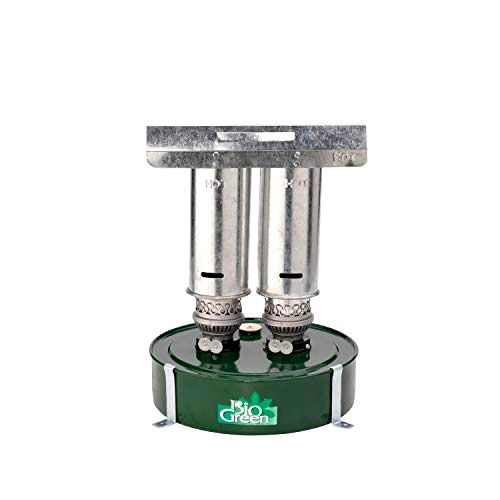

Share